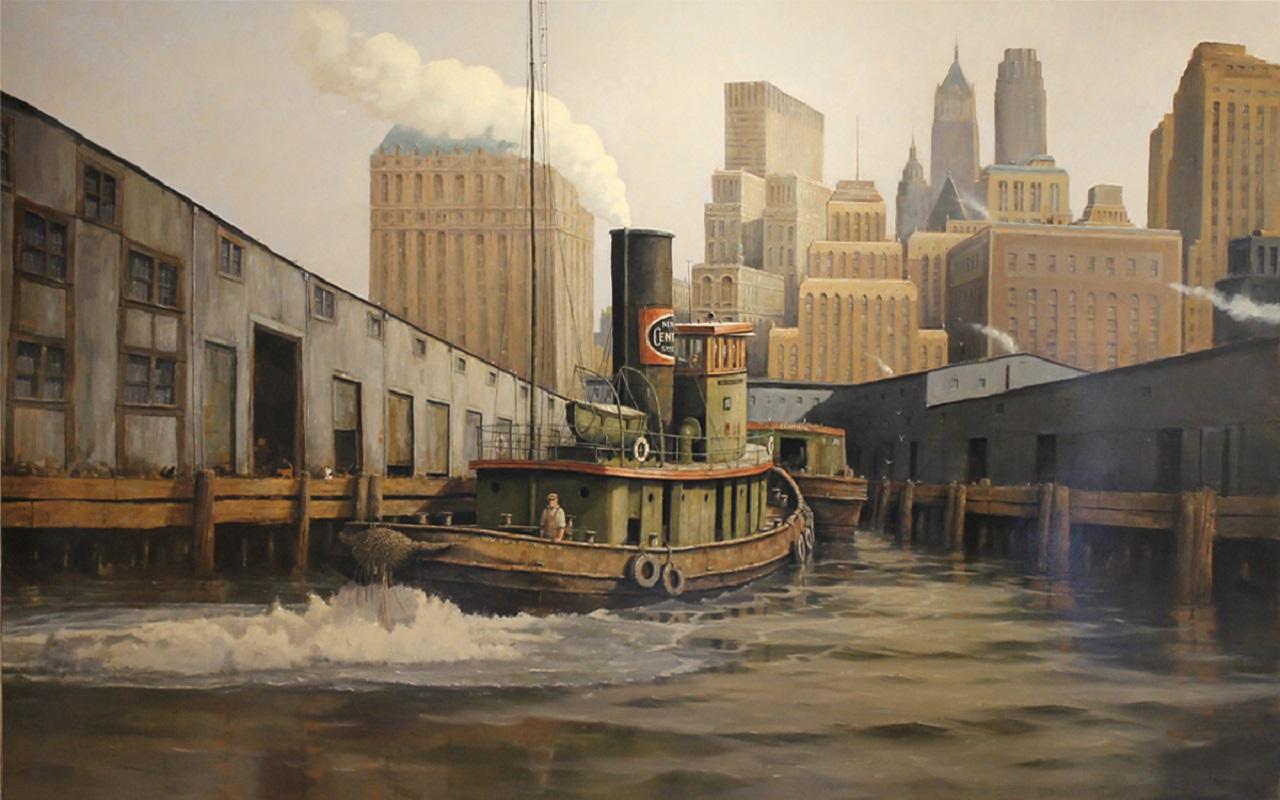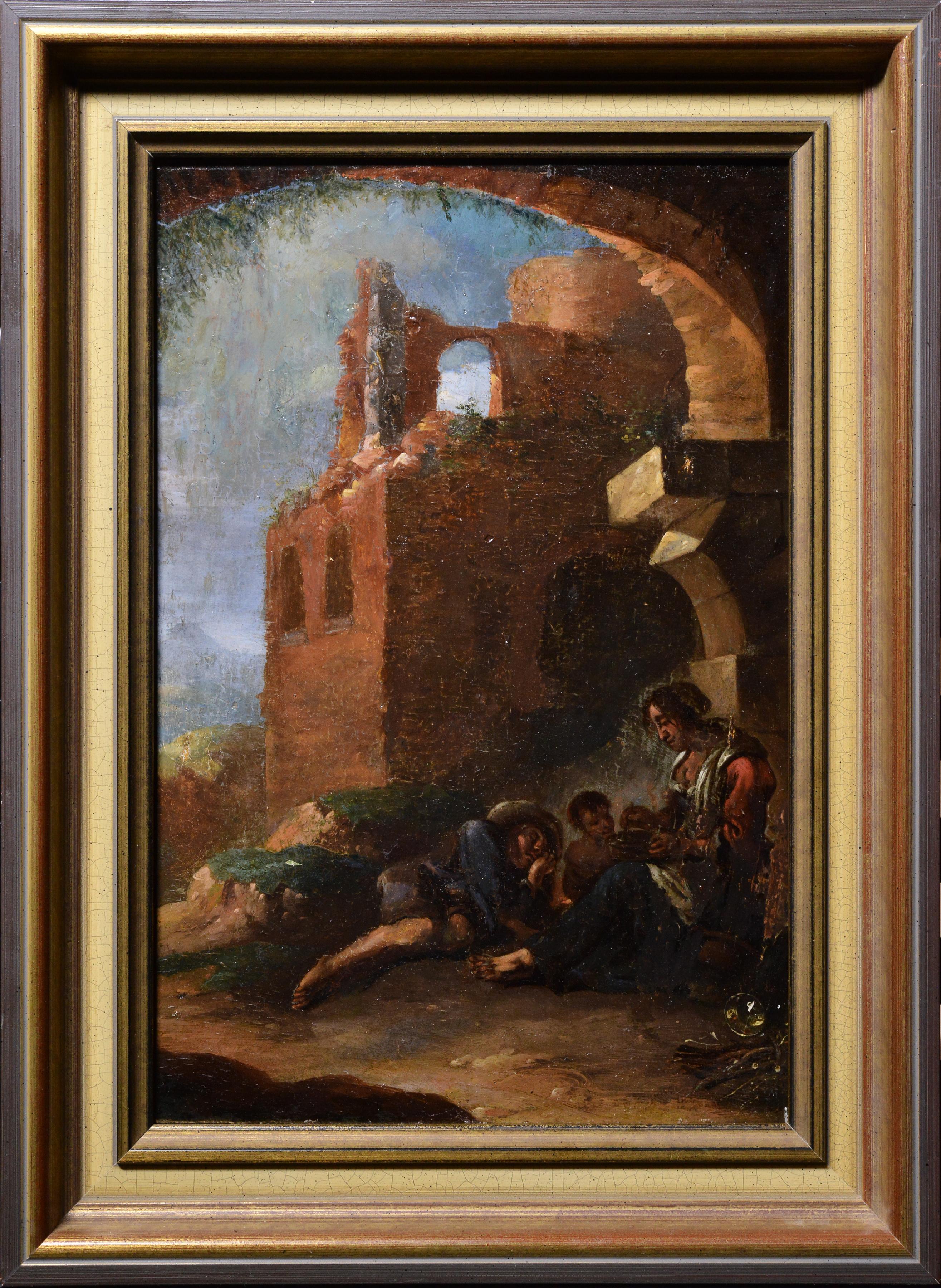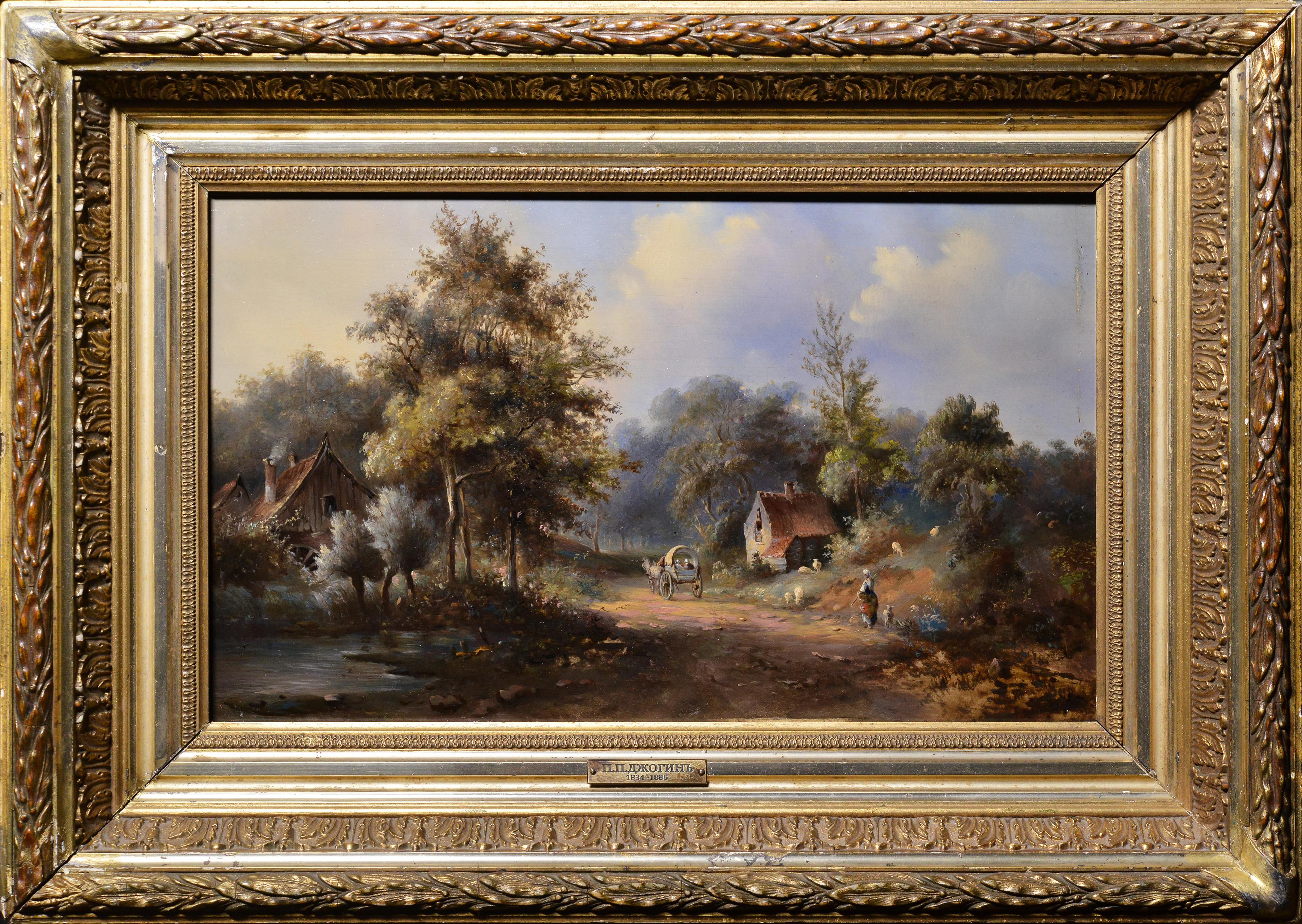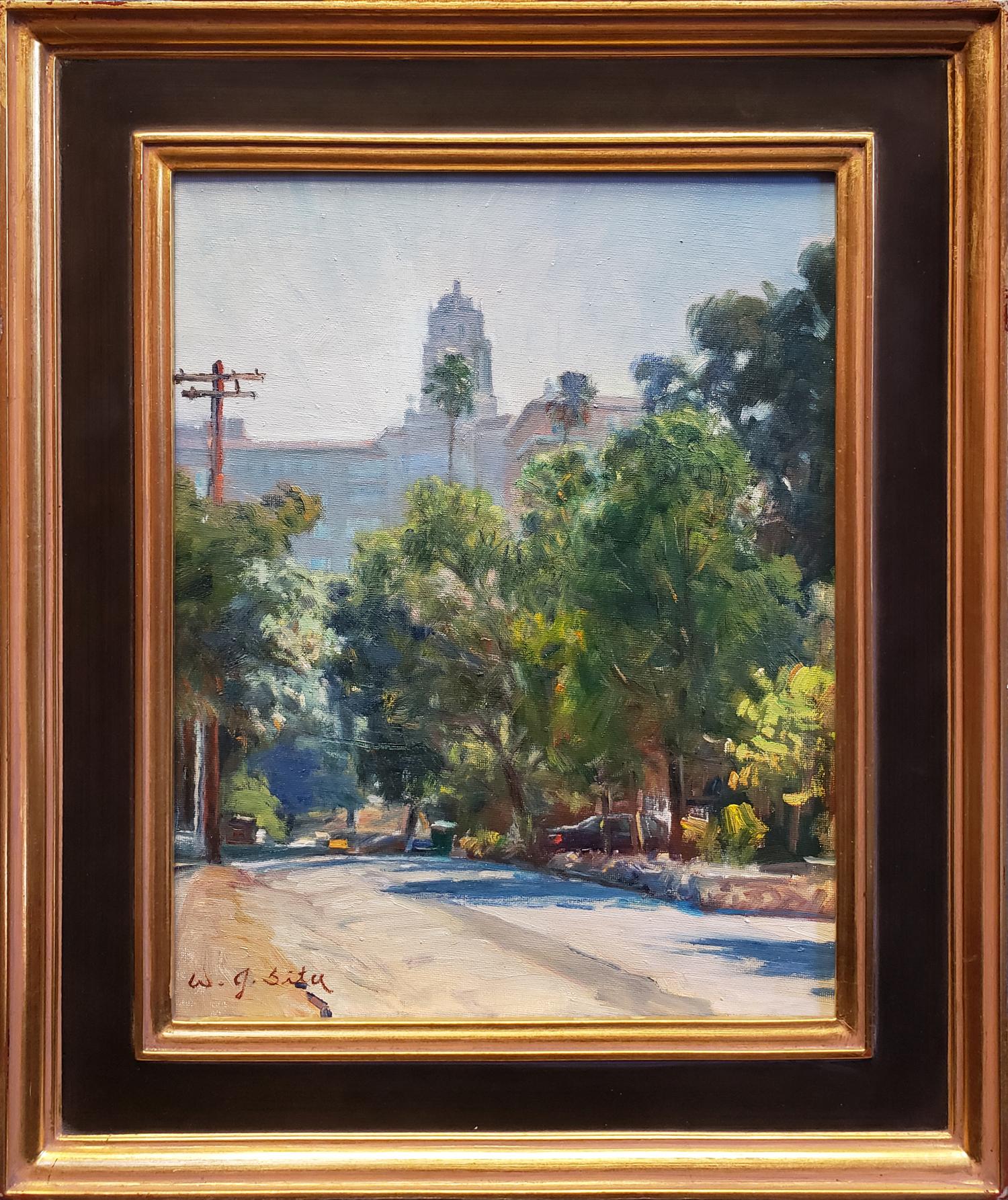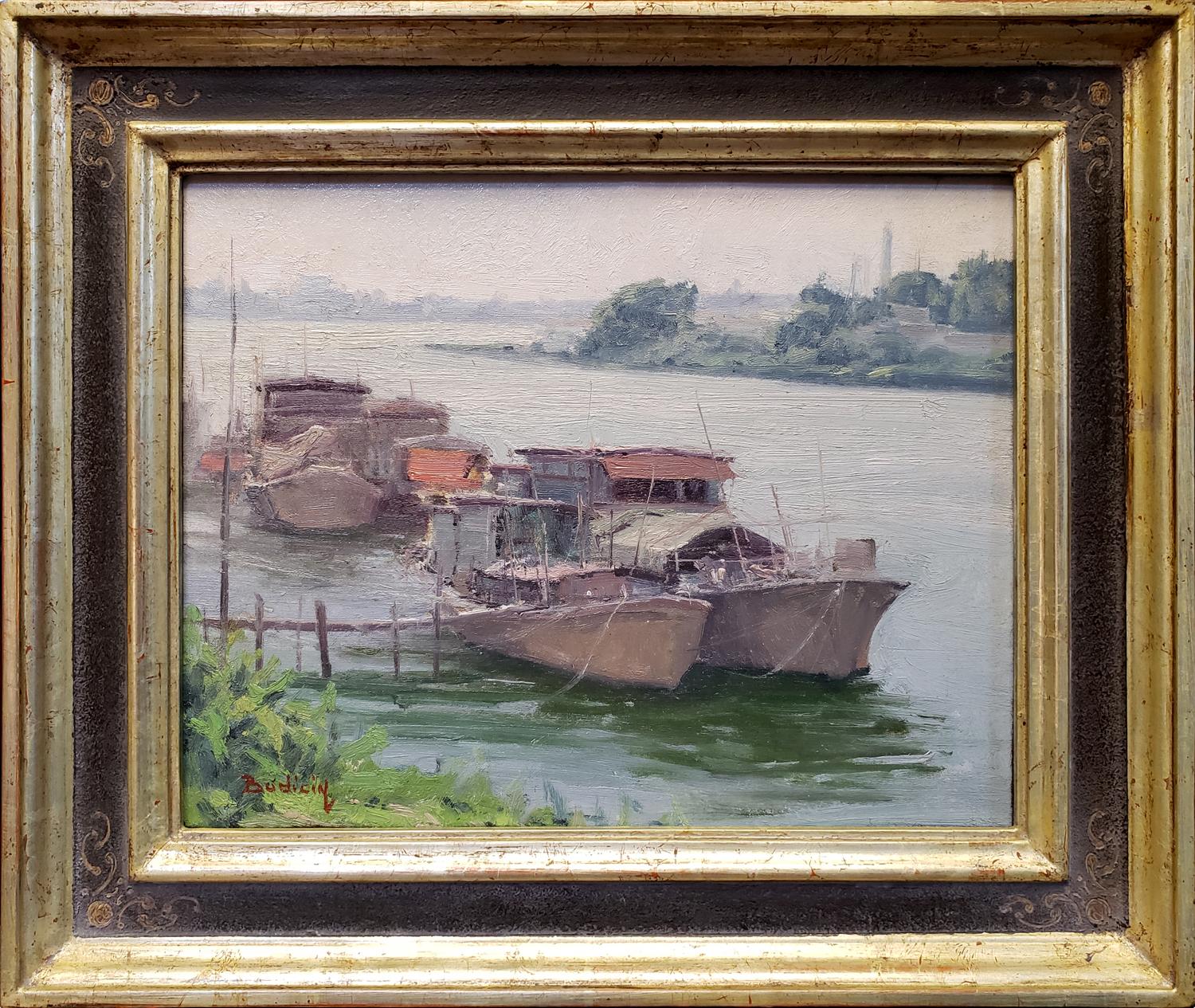Items Similar to Winter Sunlight - Realist Landscape Oil Painting by Ivan Fedorovich Choultse
Want more images or videos?
Request additional images or videos from the seller
1 of 16
Ivan Fedorovich ChoultséWinter Sunlight - Realist Landscape Oil Painting by Ivan Fedorovich Choultse1921
1921
About the Item
Signed and dated oil on canvas landscape by Russian Realist painter Ivan Fedorovich Choultse. This stunning piece depicts the winter sun shining down on a thick blanket of snow. The bare trees are creating blue shadows on the white snow and a stream runs through the landscape. The pale blue of the bright sky is just visible behind the trees.
Signature:
Signed lower left & dated 1921
Dimensions:
Framed: 30"x35"
Unframed: 21"x26"
Provenance:
Burlington Paintings - London (original labels verso)
He was born in Saint-Petersburg, Russia, into a family of German origin (Schultze — original spelling of his family name – had lived in Russia since the 17th century). His first education was in electrical engineering. At the same time he tried to paint landscapes. When he was already thirty years old, he showed his first essays to a famous painter and member of Russian Academy of fine arts Constantin Jakovlevich Kryzhitsky (1858) —1911), who then invited Choultsé to study art. Other significant influences were Russian painter Arkhip Ivanovich Kuindzhi (1841 —1910) and Swiss painter Alexander Calame (1810–1864).
Together with Kryzhitsky in 1910 Choultsé travelled to Spitzbergen, where he painted many Arctic landscapes (Datskiy and Medvezhiy islands, Saint Magdalene's bay of the Spitzbergen archipelago etc.).
After losing both of his teachers (Kuindzhi died in 1910 and Kryzhitsky committed suicide the year after) Choultsé begins to master his very own style of painting. Grand Duchess Olga Alexandrovna (1882–1960), being also a pupil of Kryzhitsly, founded a Society in the name of her late teacher and Choultsé frequently participated in its exhibitions, that took place in her palace on Sergeevskaya street, 46/48 (now Tchaikovskogo str.).
By 1916 Choultsé is already a widely famous artist, members of the Tsar family acquire his works (Nicholas II's brother Michael Alexandrovich, Grand Duke Grigoriy Mikhailovich and others). The Tsar himself is not much interested: as Choultsé noted later, in emigration, Nicholas II displayed no interest in landscapes or still lives, as they "told no story". Some works were bought by Сarl Fabergé (stated in his 1918's inventory). Post card development has greatly contributed to Choultsé's success – printing of his works on those "open letters" made him famous throughout the country.
Just like many "academic" painters, Choultsé was in great uncertainty during revolutionary years. He decides to go on a lengthy trip to Europe: it continued from 1917 till 1919. During it he painted many views of Swiss Alps, southern France and northern Italy. After the trip he briefly returned to Russia a few times.
In 1921 Choultsé returned to his homeland for a while in an attempt to win the attention of Soviet public. In Petrograd he joins the society of individualistic painters, whose members were Isaak Izrailevich Brodsky (1883–1939), Ivan Avgustovich Veltz (1866–1926), Juliy Julievich Klever (1850–1924) and Aleksandr Vladimirovich Makovsky (1869–1924). He takes part in two first exhibitions of this society, but then ultimately decides to emigrate for life.
In Paris Choultsé settles on boulevard Pereire 121, and tries to penetrate the artistic milieu of Paris, overloaded both by immigrants and by the rise of many French painters at that time. The first personal exhibition of 50 works of Ivan Choultsé opened on November 23, 1922 on Rue La Boétie, 2. The Léon Gérard Gallery exhibited Choultsé's "Soir de Novembre" ("November evening") painting at the spring 136th Salon des Artistes Francais in 1923 and then the "Derniers rayons" ("The Last Rays of Light") at the 137th Salon. The Gallery then held annual personal exhibitions of Choultsé's works up to 1925. Choultsé got French citizenship in 1927.
On March 16, 1927 a personal exhibition of Choultsé opened in Arthur Tooth & Sons Gallery on New Bond street, 155. London journal The Studio (1927, Vol. 93) described the event as a sensation in the field of classical painting: Choultsé demonstrated a new approach to the landscape and evoked a wave of interest to the old genre.
The European fame became international. Édouard Jonas, a prominent figure in French and international art market, owner of exhibition halls both in Paris and New York, offered an exclusive plan of exposing Choultsé's works in the States. On December 1, 1928 in New York gallery of Jonas on East 56th street, 9 opened Choultsé's exhibition with the slogan "It must be seen to be believed". It was open from November 15, 1929 till January 1, 1930 and held 68 works of the artist, that were willingly bought by people from the States, Canada, Argentina, Mexico.
In mid-1930s Choultsé moves to Nice, France. The last reliable account of meeting him belongs to Alexander Iosifovich Gefter (1885–1956), a marinist painter, member of various underground antibolshevik organisations and mason. He saw Choultsé on March 7, 1936 during a meeting of Russian emigrants in Breton castle on rue Saint Antoine in Nice. His gravestone on Russian Orthodox Cemetery in Nice states 1939 as the year of his death.
Meanwhile, there were some exhibitions of his works held after his departure and even after his death in New York City (April 1936, April 1940 and May 1943) and Oklahoma City (May—June 1938).
Choultsé's works are scarce in Russia, as Russian museums nowadays mostly lack his works, with rare exceptions of Saint Petersburg Arctic and Antarctic Museum and Dagestan Fine Arts Museum. His works can though be frequently found in American and Canadian collections (Hillwood Museum in Washington D.C., WSU Museum of Art (Washington State University), Indianapolis Museum of Art, Montreal Museum of Fine Arts). Many works are part of private collections.
- Creator:Ivan Fedorovich Choultsé
- Creation Year:1921
- Dimensions:Height: 30 in (76.2 cm)Width: 35 in (88.9 cm)
- Medium:
- Movement & Style:
- Period:
- Condition:Very good original condition.
- Gallery Location:Marlow, GB
- Reference Number:
About the Seller
5.0
Platinum Seller
These expertly vetted sellers are 1stDibs' most experienced sellers and are rated highest by our customers.
Established in 2001
1stDibs seller since 2016
673 sales on 1stDibs
Typical response time: 2 hours
- ShippingRetrieving quote...Ships From: Marlow, United Kingdom
- Return PolicyA return for this item may be initiated within 3 days of delivery.
More From This SellerView All
- La Marchande de Fleurs - French Realist Figurative Oil by Victor GilbertBy Victor Gabriel GilbertLocated in Marlow, BuckinghamshireSigned figurative oil on original canvas by French realist painter Victor Gabriel Gilbert. The work shows a flower seller filling a young girl's basket with cherries while a little b...Category
1910s Realist Figurative Paintings
MaterialsCanvas, Oil
- Sunset, Sables - Figurative Realist Oil, Boats in Seascape -Georges MaroniezBy Georges MaroniezLocated in Marlow, BuckinghamshireSigned realist oil on canvas seascape circa 1900 by French painter Georges Philibert Charles Maroniez. This stunning painting depicts two fishermen looking out over the harbour at Le...Category
Early 1900s Realist Landscape Paintings
MaterialsOil, Canvas
- Fishing in Vejle Fjord - Realist Oil, River Landscape by Peder Monk MonstedBy Peder Mørk MønstedLocated in Marlow, BuckinghamshireA charming riverscape oil on canvas by Danish Realist painter Peder Mork Monsted. The painting depicts a beautiful spring landscape on a bright day. A man stands fishing on the bank of a river outside a pink cottage. Flowers are bursting into life on the riverbank and int he cottage garden. Signature: Signed, titled and dated 1920 lower left Original artist's label verso Dimensions: Framed: 20"x26" Unframed: 14"x20" Provenance: Private collection - Denmark Mønsted was born at Grenå, Denmark. He was the son of Otto Christian Mønsted and Thora Johanne Petrea Jorgensen. His father was a prosperous ship-builder. At an early age, he began to receive painting lessons at the art school in Aarhus. From 1875 to 1879, studied at the Royal Academy of Fine Arts with Niels Simonsen and Julius Exner. In 1878, Mønsted studied under the artist Peder Severin Krøyer. In 1882, he spent some time in Rome and Capri then, the following year, visited Paris, where he worked in the studios of William Adolphe Bouguereau. In 1889, he went to Algeria. Three years later, he travelled to Greece, where he was a guest of King George I who had been born a Danish prince. While there, he also did portraits of the Greek royal...Category
1920s Realist Landscape Paintings
MaterialsOil, Canvas
- Coucher de Soleil - Dieppe - Realist Oil, Boats in Seascape by Alfred StevensBy Alfred Émile Léopold StevensLocated in Marlow, BuckinghamshireSigned and dated seascape oil on canvas by Belgian Realist painter Alfred Emile Leopold Stevens. The work depicts a sail boats off the coa...Category
1890s Realist Landscape Paintings
MaterialsOil, Canvas
- Jardin en Ete - Impressionist Landscape Oil Painting by Leon Giran-MaxLocated in Marlow, BuckinghamshireSigned impressionist oil on panel landscape circa 1900 by French painter Leon Giran-Max. The work depicts a view of fenced garden with pink flowers contrasting against the green foli...Category
Early 20th Century Impressionist Landscape Paintings
MaterialsPanel, Oil
- Fete Champetre - Symbolist Figurative Oil Painting by Ker Xavier RousselBy Ker Xavier RousselLocated in Marlow, BuckinghamshireSigned symbolist oil on panel circa 1910 by French Les Nabis painter Ker-Xavier Roussel. This beautiful painting depicts nudes and figures dressed in robes in a wooded landscape. Signature: Signed lower left Dimensions: Framed: 31"x40" Unframed: 23"x32" Provenance: JPL Fine Arts - London c. 1985 Ker-Xavier Roussel met Édouard Vuillard at the Lycée Condorcet, which they both attended. Together they visited Eugène Ulysse Napoléon Maillard's studio, where Roussel became acquainted with Charles Cottet, going on to study at the Académie Julian under Bouguereau and Jules Lefebvre. There, he became interested in the Synthetism promoted by Sérusier, following Sérusier's heeding of the line Gauguin had adopted in Pont-Aven. He joined the Nabis group. He and his friends form a link between the Impressionists - he knew Cézanne, Degas, Renoir and Monet - and the Fauves and Cubists. In his earliest paintings, Roussel adopted a dark palette for Realist still-lifes. Later, his work bore the influence of Gauguin, Sérusier, the Nabis and Cézanne, in Intimist scenes painted in flat tints not yet clearly delineated. Their dull, saturated tones are reminiscent of Cézanne. In about 1900 he started painting mythological scenes full of nymphs and fauns and set in his home region of Île-de-France. After a bicycle trip in Provence with Maurice Denis, during which he met Cézanne, he lightened his palette, much taken by the cloudless skies below which he would now set the mythological and idyllic compositions which link him to Poussin and Corot. This wondrous, unreal world found its way into large-scale works, including the stage curtain of the Champs-Élysées theatre in 1913, a large Pax Nutrix for the Palais des Nations in Geneva and Dance for the Palais de Chaillot in 1937. He is best remembered for: Silenius' Triumph, Polyphemus, Diana, The Abduction of the Daughters of Leucippus. The nymphs and fauns of a mythology quite his own appear in clearings and woods from the outskirts of Paris, but the sun they rejoice in is Mediterranean. To capture the vibration of bright colours under a permanent sun, he later turned to pastels. He was more a Symbolist than a Nabi and signed himself K.-X. Roussel. He also produced lithographs. He took part in exhibitions from 1891 with the Groupe des Vingt at le Barc de Bouteville's gallery in Brussels. Then he exhibited in Revue Blanche Painters ( Les Peintres de la revue blanche) in Paris; with the Nabis at Café Volponi in Paris; before World War I with Free Aesthetics in Brussels; from 1901 at the Salon des Indépendants and the Salon d'Automne; in the 1930s in Revue Blanche Painters ( Les Peintres de la Revue blanche) hosted in Paris by designer Bolette Natanson, the daughter of the Revue Blanche's owner. He took part in The Masters of Contemporary Art ( Les Maîtres de l'art contemporain) at the Musée du Petit Palais in Paris, and at the 1938 Venice Biennale and 1939 New York World Fair. He featured posthumously in Toulouse-Lautrec and the Nabis ( Toulouse-Lautrec et les Nabis) at Bern Kunsthalle; From the Revue Blanche ( Autour de la revue blanche) in the Galerie Maeght, Paris, and in Tokyo and Brussels. He had one-man shows in Paris before his death in 1944. Retrospectives were mounted in the 1960s in London and Bremen. Museum and Gallery Holdings: Geneva (Petit Palais): Haystacks on the Seaside Paris (BNF): Training the Dog; Landscapes (engraving); Nymph and Faun (c. 1895, etching) Paris (Louvre): Poject for a Screen (drawing) Paris (MNAM-CCI): The Road (c. 1905); The Cyclops (1908); Venus and Cupid on the Seafront (1908); The Abduction of Leucippus' Daughters (1911); Pastorale (1920); Diana at Rest (1923); Portrait of Vuillard (1934) Paris (Mus. d'Orsay): The Gate (pastel); Woman in Profile with Green Hat; In Bed; Félix Valloton...Category
Early 20th Century Symbolist Figurative Paintings
MaterialsOil, Panel
You May Also Like
- Backing DownBy Nicholas BergerLocated in Greenwich, CTA steamboat at Hudson River Pier.Category
2010s Realist Landscape Paintings
MaterialsOil, Panel
- Italian Grotto in Ruins Street Scene with Resting Family 18 Century Oil PaintingLocated in Stockholm, SEVery well executed mid-18th century artwork, rather oil study, depicts resting family sheltering from the scorching midday sun in grotto shape arch in ruined part of town. Mother fee...Category
Mid-18th Century Realist Landscape Paintings
MaterialsWood, Oil, Wood Panel
- Pastoral Country Landscape Travelers on a Forest Road 19th century Oil PaintingLocated in Stockholm, SEBrass plate leads to Russian artist Pavel Pavlovich Dzhogin (1834 - 1885). This 19th century oil painting beautifully captures a serene rural scene with travelers on a cart traveling...Category
Late 19th Century Realist Landscape Paintings
MaterialsWood, Oil, Wood Panel
- Pasadena AtmosphereBy W. Jason SituLocated in Pasadena, CAProvenance Acquired by the gallery directly from the artist Exhibited Fleeting Moments 2nd Biennale: Works en Plein Air, American Legacy Fine Arts, November 22 – December 15, 2019 ...Category
2010s Realist Landscape Paintings
MaterialsOil, Panel, Canvas
- Peaceful Passage; Batiquitos Lagoon, Carlsbad, CaliforniaBy Peter AdamsLocated in Pasadena, CAProvenance Acquired by the gallery directly from the artist Description Peter Adams' flare for combining real places with dreamlike visions is exemplified in this plein air oil pain...Category
2010s Realist Landscape Paintings
MaterialsOil, Panel
- Home Sweet Home; Kaiping, ChinaBy John BudicinLocated in Pasadena, CAProvenance Acquired by the gallery directly from the artist Artist Statement "While painting by the river a swarm of children came to see what I was doing. I enjoyed their enthusias...Category
2010s Realist Landscape Paintings
MaterialsCanvas, Oil, Panel
Recently Viewed
View AllMore Ways To Browse
Revolutionary Paintings
Antique Classical Painting
Landscape Oil Painting Sun Light
Argentina Antique Art
Landscape Oil Painting Market
Painting Antique Winter
Old Master Style Landscapes
17th Landscape Oil
Paris Painting Winter
French Old Master Landscape
Oil Painting Winter City
Italian Old Masters Landscape Painting
17th Century Oil Landscapes
Soviet Landscapes
Sunlight Trees
German Paintings 1930s
Rare Antique Oil Painting
Antique Oil Paintings People
